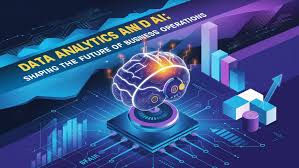AI and Data Analytics: A Powerful Duo for the Future
- pallavi chauhan
- Oct 30, 2024
- 4 min read

As we advance in the digital age, the blend of artificial intelligence (AI) and data analytics is transforming industries worldwide. Together, they provide organizations with the tools to harness vast datasets, reveal hidden patterns, and drive strategic decisions through powerful insights.
1. Defining Data Analytics and AI
To understand their combined potential, let’s clarify data analytics and AI. Data analytics involves systematically analyzing raw data to extract insights, recognize trends, and inform decisions. It employs methods such as statistical analysis, data mining, and predictive analytics.
AI, on the other hand, focuses on designing algorithms and systems that emulate human intelligence—learning, problem-solving, and reasoning capabilities. A subset of AI, machine learning (ML), allows algorithms to improve as they analyze more data. Together, AI and data analytics offer enhanced insights, predictive abilities, and a level of automation unmatched by either field alone.
2. How AI Elevates Data Analytics
AI enhances data analytics by automating intricate processes, enabling real-time analysis, and generating detailed insights. Here’s how AI amplifies the potential of data analytics:
Automation of Data Processing: AI can handle repetitive data preprocessing, organizing, and cleaning tasks, improving data accuracy and freeing experts to focus on more advanced analysis.
Advanced Predictive Analytics: AI and ML algorithms excel at analyzing historical data patterns, enhancing predictions across sectors. In retail, for example, AI-based predictive analytics helps forecast demand, optimize inventory, and understand consumer trends.
Real-Time Decision-Making: For industries where quick decisions are crucial, AI-driven analytics enables real-time monitoring and immediate action. Financial institutions, for instance, employ AI models to detect and act on suspicious transactions instantly, improving security.
Natural Language Processing (NLP): AI’s NLP capabilities make it possible to analyze unstructured text data, such as customer feedback or social media comments. NLP allows companies to understand sentiment, identify trends, and improve customer relations.
3. Industry Applications of AI-Enhanced Data Analytics
The combination of AI and data analytics has vast applications across industries, transforming traditional processes and offering competitive advantages:
Healthcare: AI-driven analytics can help predict patient outcomes, diagnose diseases, and personalize treatments. By analyzing patient data, AI models can identify high-risk cases early, enhancing intervention and care.
Finance: Financial firms use AI-driven analytics to assess credit risk, detect fraud, and make investment decisions. Machine learning algorithms recognize fraudulent patterns, improving security. AI also aids in customer segmentation, leading to more personalized service.
Retail and E-commerce: Retailers apply AI-powered analytics to understand customer preferences, optimize pricing, and manage inventory. AI-based recommendations on e-commerce sites boost satisfaction and sales by tailoring products to individual needs.
Manufacturing: In manufacturing, AI and data analytics enable predictive maintenance, reducing downtime and prolonging equipment life by forecasting potential breakdowns.
Logistics and Supply Chain: Logistics companies use AI to optimize supply chains, forecasting demand, managing inventory, and planning efficient delivery routes.
4. Key Benefits of Combining AI and Data Analytics
The fusion of AI and data analytics offers several advantages that surpass traditional methods:
Enhanced Efficiency and Accuracy: Automation through AI improves accuracy by reducing human error, streamlining data processes, and delivering reliable results.
Scalability: AI-powered data analytics handles large datasets effortlessly, adapting to growing data volumes and allowing companies to remain agile.
Deeper Insights: AI's pattern-recognition abilities uncover relationships and trends that traditional analytics might miss, allowing for better-informed decisions.
Improved Customer Experience: AI analytics enables companies to deeply understand and personalize customer experiences, fostering loyalty and satisfaction.
Cost Reduction: Automated processes reduce operational costs. Predictive maintenance in manufacturing, for instance, prevents costly breakdowns, while inventory management in retail minimizes stock-related expenses.
5. Challenges in Merging AI with Data Analytics
While the benefits are clear, integrating AI and data analytics poses challenges:
Data Privacy and Security: Data-driven approaches come with privacy concerns. Companies must protect sensitive data and adhere to regulations like GDPR.
Data Quality: AI’s effectiveness depends on high-quality data. Inaccuracies or inconsistencies can lead to flawed insights, making data integrity critical.
Skill Gap: Implementing AI-driven analytics requires skilled talent in AI and data science. Companies must invest in training or recruiting specialized staff.
Implementation Costs: AI-based analytics can be expensive, especially for smaller businesses, though the investment often leads to long-term gains.
6. The Future of AI-Driven Data Analytics
As AI and data analytics continue to evolve, several trends are likely to shape the future:
Augmented Analytics: Integrating AI and machine learning with data analytics to automate insight generation. This makes analytics more accessible to non-experts, allowing more employees to leverage data-driven decision-making.
AI-Powered Data Governance: AI will automate data governance, ensuring data quality, security, and compliance with increasing regulatory demands.
Ethical AI in Analytics: With AI’s growing role, ethical considerations like fairness, transparency, and accountability will be essential to prevent bias and ensure equitable outcomes.
IoT Integration: The Internet of Things (IoT) generates vast data volumes. AI will analyze this data in real time, transforming sectors like healthcare, smart cities, and transportation.
Conclusion
The combination of AI and data analytics is revolutionizing industries, allowing organizations to make more informed, faster decisions. With the best data analytics training course in Delhi, Noida, Gurugram, Mumbai, Navi Mumbai, Thane, and other cities across India, professionals are equipped to harness these advancements effectively. While challenges remain, the potential benefits—such as increased efficiency, personalized experiences, and cost savings—are substantial. As technology advances, AI-driven data analytics will continue to democratize insights, paving the way for innovation across industries.







Comments